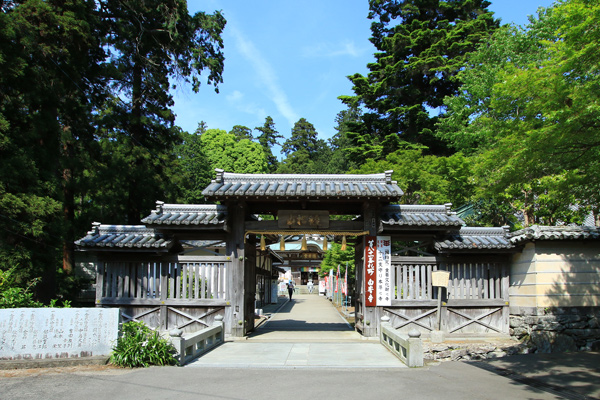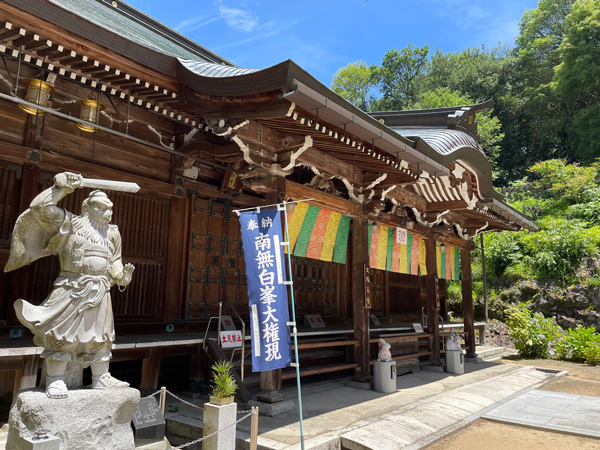The Shikoku Pilgrimage Temple Guide
Temple 81, Shiromineji

Precinct map

History of the temple
Shiromineji is located in the middle of Kagawa Prefecture on the sacred mountain Goshikidai. Goshikidai has five peaks: Aomine, Kinomine, Konomine, Shiraminesan, and Kuromine (Blue Mountain, Yellow Mountain, Red Mountain, White Mountain and Black Mountain). Shiromineji stands on the westernmost peak, Shiraminesan. It is an old, quiet temple. There is a magnificent view of Seto Inland Sea from the approach to the temple. Shiromineji was founded by Kobo Daishi and his nephew, Chisho Daishi in 815, when Kobo Daishi buried a nyoi hoju (a wish-fulfilling jewel), dug a well, and prayed for the salvation of mankind from the top of Mt. Shiramine. Later, Chisho Daishi climbed up the mountain, guided by a mysterious light which he considered the Light of Fortune. He had a vision of a white-haired old man, the local deity, and saw a sacred tree appear in the Seto Inland Sea, shining with light and giving out a fragrant odor. He carved a statue of Senju Kannon (Thousand-armed Bodhisattva Who Hears the Sounds of the World) from the sacred tree and built a Buddhist temple with the statue as the principal image.
The pleasant-sounding name of the temple, Shiromineji, comes with two famous stories. The first story tells about Emperor Sutoku, who was defeated in the Hogen Rebellion (a civil war in Kyoto in 1156) and exiled to Sanuki (Kagawa). Sutoku died here without being able to fulfill his wish of returning to the capital. He was cremated on Chigogadake Mountain and a mausoleum was built there, as directed in his will. Then, because of a succession of unusual events in the capital, emperors, court nobles, and military commanders from generation to generation feared the emperor. They dedicated imperial land and offered Buddhist music, poems, and various sacred objects and treasures to express their sincere condolences. In particular, the 100th emperor, Go-Komatsu, expressed his respect by dedicating an imperial inscription entitled Tonshoji to the Hokkedo, the building that enshrines the Emperor's spirit.
The temple is also famous for Tales of Moonlight and Rain by Ueda Akinari. In 1166, Saigyo Hoshi, who was a friend of the emperor, composed a poem when he visited the mausoleum to offer his condolences. On the temple grounds is a Tamazusa no ki tree that tells the tragic story of the emperor.
A legend tells that Sagamibo, one of the Eight Great Tengu (tengu are Japanese legendary creatures) lives at Mt. Shiramine. Sagamibo has a very warm heart. When a monk ordered a younger monk to go out to buy some tofu because he had a sudden visitor, someone suddenly pushed the young monk back. He felt as if he were flying through the air. The next moment, he was standing where he had been, having received a fine piece of tofu of a kind he had never seen in the countryside. It is said that this was because Sagamibo Tengu felt sorry for the little boy who was suddenly forced to run out and go shopping, so the tengu helped him out.
In the past, the temple was elaborate, with 21 pagodas, but it also suffered from frequent fires caused by lightning and invasions. The present temple was rebuilt by feudal lords of the Ikoma and Matsudaira families.
Highlights
Chogakumon and Tonshoziden
These were built by Matsudaira Yorishige, Lord of the Takamatsu, and are very elaborate in both decoration and structure. They are extremely valuable buildings, with outstanding features, based on special Japanese-style form and design. They are unique in Japan in that they enshrine the Emperor, God, and Buddha, all together.
Eto Mamori Principal Image
There are buildings on the temple grounds that enshrine as its principal image a representation of one of the Chinese zodiac signs. After visiting the Hondo and the Daishido, many worshipers visit the hall where the guardian deity of their zodiac sign is enshrined.
Cultural Properties
There are many National Important Cultural Properties at Shiromineji. Among the buildings so designated are two thirteen-storied stone pagodas, a temple gate (Shichimunamon), the Onarimon, the Chokushimon, the Kyakuden, the Chogakumon, the Tonshojiden, the Yakushido, the Gyojado, the Amidado, the Hondo, and the Daishido. Among the designated artwork is the Tonshoji imperial plaque. The temple also has many other Designated Cultural Properties.
The Emperor's Tomb
The tomb of Emperor Sutoku, called Shiromine no Misasagi, is located within the temple precincts. Shiromineji is the only pilgrimage temple that contains an imperial tomb. There is a hall on the temple grounds to enshrine an image of each of the animals of the Chinese zodiac. Sagarabo or Shiromine Daigongen, one of the Eight Great Tengu in Japan, is also enshrined here.

Annual Events
| January 1-3 | New Year's Prayer Ritual |
| Last Sunday in January | Goma Fire Ritual |
| February 3 | Star Ritual for Warding off Evil |
| Last Sunday in April | Soil Memorial Service |
| July 10 | Principal Image, Senju Kannon Bosatsu Day |
| September 21 | Memorial Service for the emperor Sutoku |
| 1st Sunday in November | Wisdom Sutra Chanting |
| Winter Solstice, December 22 | Star Ritual for Warding off Evil |
| New Year’s Eve 23:45 | New Year’s Eve bell |
| 28th of each month, Except for January and April | Goma Fire Ritual |
Details
Names: Ryōshōzan Dōrinin Shiromineji
Denomination: Shingon sect,Omuro school
Principal Image: Senju Kannon Bosatsu
Founder: Kobo Daishi, Chisho Daishi
Founded: 815
Access
Address: 2635 Omi Town, Sakaide City, Kagawa 762-0016
Phone: 0877-47-0305
Parking: Available (free, about 200 cars)
Lodging: Available (spring and fall only, group only, irregular holidays, reservations required)
Official website: https://www.shiromineji.com/
Instagram:shiromineji81
X:@shiromineji
